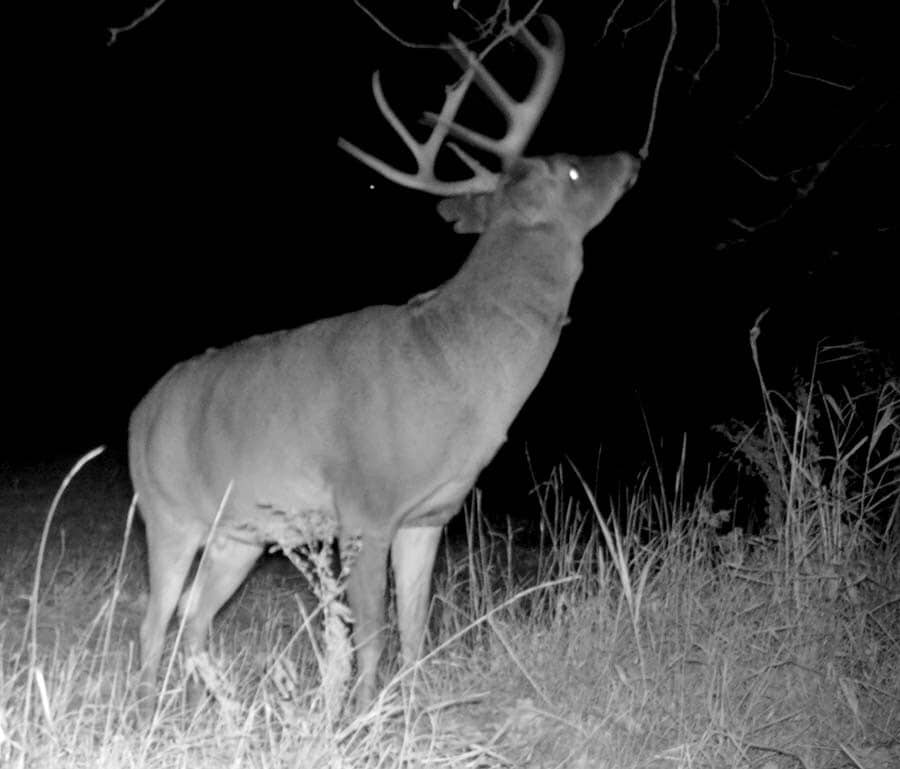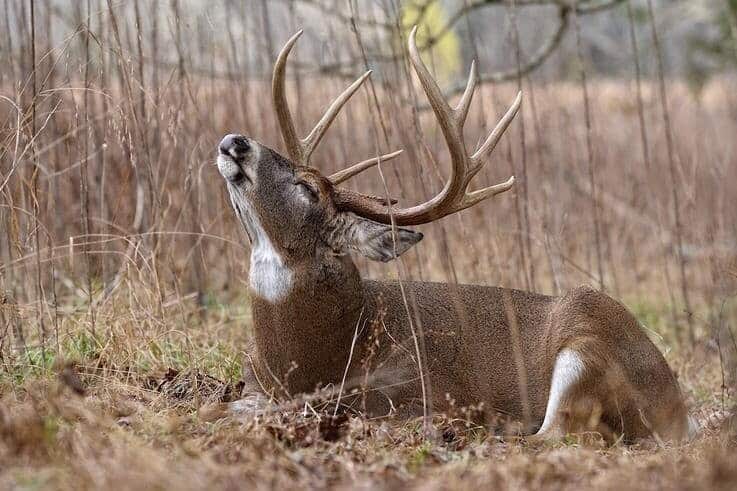One of the most aggravating things in the world, as a hunter, is to sit in your stand all day and not see a deer. This is especially annoying if it happens often. If you are hunting an area and are not seeing any deer, what are you doing wrong? Well, there are plenty of possibilities and in this article, we will go through them all.
As a general rule, if you are not seeing deer on your property, you may have done poor scouting, or your property is not able to support deer. You could also be scaring deer away with poor scent control, or overhunting. Thankfully, many of these problems are fixable with a little effort.
First, let’s take a look at the basics of what you could be doing on your property to bring in and hold deer, and then we will look at the smaller reasons you may not be seeing deer.

Give Deer a Reason to Be on Your Property
Generally, most tracts of land will have enough resources to support a population of whitetail. That population may be small, but there are steps we can take to increase how many deer a particular property can hold. I have an entire article about attracting deer to your property with physical tactics you can do this year, you can read it here.
Deer need three things to live: food, water, and shelter/safety. The better a property does at providing these things for deer, the more deer it will hold. Plus, with proper management, the property will also start to hold more quality and mature bucks.
If your property does not have a large amount of preferable food sources then why would deer spend their time there? This is especially true if a property nearby has a better natural or man-made food source.
To combat this, you can plant a food plot or two around your property. This will provide the deer that are in the area a much better source of nutrition. If this is the best food in the area, then you will also attract many more deer. Generally, more food equals more deer.
I should also note that pouring a bag of corn out in a pile is not providing deer with a good food source. That may work to bring in deer in the area for a little while, but if an area is already not seeing any deer, your corn is going to be eaten by birds and raccoons and then mold over.
Making your property the safest in the area will also attract more deer, especially if the properties around you are intensely hunted. Although we will talk more about overhunting later, having ample cover on your property will make bucks feel safer. With plenty of cover, bucks will spend more time there and possibly make it a bedding area.
You’ve Got Deer Sign but Haven’t Seen Deer
If you are seeing plenty of deer sign, make sure it is from this year. Old rubs and old scrapes are deceiving at times. Just because deer were using those rubs and scrapes last year does not mean they are this year.

If you are hunting over a scrape or rub line, make sure that the buck that uses them is not nocturnal. Hang a few trail cameras around and see what visits and when. If the deer visiting those scrapes or rubs are nocturnal, read this guide here.
If you are hunting areas that have a lot of tracks but you are not seeing deer, those deer may be visiting that area at night and not during the day, so you need to do some more scouting and figure out where deer are spending their time in the daylight. Trail cameras can help out a ton here. Place a camera around your hunting area and see when deer are there, then adjust accordingly.
Another reason you are not seeing deer may be that you are not hunting long enough. If you are only hunting for a few hours in the morning or the evening, stay in the stand longer. Deer move the majority of the time in the mornings and evenings, but they may be moving through your area a little later.
You’re Hunting the Wrong Area
It is possible that your scouting was just not on point this season. It happens. One mistake that many hunters make after scouting all preseason is hunting areas where they saw a lot of deer during the summer. Deer are not going to use the same habits in the fall as they did in the summer. So, you should not expect those deer to still be in that area come fall.
Scouting itself is a challenging skill that takes years to hone, but if you are at a loss as to what to do, bring it back to the basics. Deer spend most of their time feeding when they are not bedded down. So, find the best food source in the area and hunt nearby it.
It is even better if you have some sort of idea of where deer may be bedding. Then you can hunt those trails between the bedding areas and food sources. If you are not sure where the bedding areas on your property are, read my guide to bedding areas here.

If you are already hunting near what you think is the best food source and have scouted to the best of your ability and are still not seeing deer, well then it may be time to change hunting properties. If you are leasing land, consider a different property next season. Although if you own the property it is time to start working to improve the property and make it more suitable for whitetail.
Practice Better Scent Control and Access Routes
There may be plenty of deer on the property, but they may smell you before you even get in your stand. You need to make sure you are practicing proper scent control and you are using short access routes to your stand.
Make sure you are taking scent-free showers, washing your clothes in scent-free detergent, and spraying down all your gear that can’t be washed with a scent-free spray. Then, make sure the trail you take to your stand is not the same one you expect deer to come from.
If there is anything at all wrong with your scent control, deer are going to smell you on that trail and will turn the other way before you ever get a chance to see them. I recommend making a trail during the preseason that goes straight to your stand from the tree line, you can even rake it out to make it quieter during entry.
This will keep deer away from your scent trail and will give you a better chance at fooling their noses. Then it is just all about being in the right area at the right time.
Plenty of people like to make scent control super complicated, but it is really not that hard and it can make all the difference in the stand. If you are continually running deer off due to your scent, they will be wary of that spot for a while. So, fix your scent control and try another area.
What if You Are Only Seeing Does
If you are only seeing does, that is not the worst thing in the world. Mature bucks will stay in the thickest and safest areas on the property most of the year. Plus, where there are does, bucks are soon to follow.
During the rut you will see many more bucks chasing the does that you have seen all season, so it just takes a little bit of patience and you will eventually see more bucks near the rut.

Many times when people have this particular problem they start to talk about the buck to doe ratio of the property. They say they have 15 does for every buck on the property, but that is simply not true.
Yes, there are more does than bucks on your property, but unless the property is severely overhunted by many hunters (which is the case in many public lands) then your doe to buck ratio is going to be more around 3-6 does for every buck. For most unmanaged lands around the United States, there are between 3 to 5 does for every buck.
This ratio can be managed and ideally we would like a 1 to 1 or 1 to 2 does to every buck, although if a property is just left alone for just 2 to 3 years, it can recover from even the most severe buck to doe ratios.
Granted, when nature fixes this ratio, you will have many more younger bucks. Nature only cares about organisms that can breed, not how big they are. So, this is where we need to use a little quality deer management to build up a population of mature bucks on a property.
I have an entire article about this ratio and how you can manage it that you can read here.
Is Your Property Overhunted?
The last problem may simply be that your property is overhunted. How many people are hunting your property? Are you out there every single week jumping deer or allowing other people to hunt it?
The more people there are on a property, the less safe the deer are going to feel. If they do not feel safe, they will go somewhere they do feel safe, even if you have the biggest food plot on the planet.
So, limit the number of people that are allowed to go on your hunting land, and try to stay out of it yourself if you are not hunting. When you are hunting, use good scent control and spend as little time on the ground as possible.
Having the safest property around will make more bucks come to your property and will have more deer, in general, staying on your property. This is especially true if the properties around you are often hunted, like in the case of public lands.
Thank you for reading my article! I hope you enjoyed it, and if you have any questions or feedback, please send me an email at Patrick.Long@omegaoutdoors.net. If you want to learn more about me or Omega Outdoors, visit my About Page. Otherwise, I hope you have a great day, and check out some of my other articles while you’re here!
